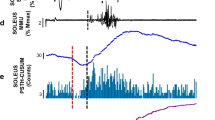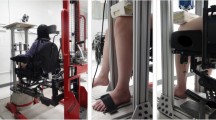Abstract
The H-reflex is depressed for seconds if elicited following a single H-reflex or train of H-reflexes. Presynaptic inhibition from flexor afferents (tibialis anterior) onto soleus Ia afferents elicited by either single or trains of stimuli had no effect on the soleus H-reflex on a time scale of seconds. Postsynaptic inhibition was also excluded by magnetic stimulation tests that showed that the excitability of the motoneuron pool was not changed at latencies within a range of seconds. Homosynaptic depression localized at the presynaptic terminal seems to be the mechanism behind the H-reflex depression in humans.
Similar content being viewed by others
Author information
Authors and Affiliations
Additional information
Received: 16 October 1996 / Accepted: 7 April 1997
Rights and permissions
About this article
Cite this article
Kohn, A., Floeter, M. & Hallett, M. Presynaptic inhibition compared with homosynaptic depression as an explanation for soleus H-reflex depression in humans. Exp Brain Res 116, 375–380 (1997). https://doi.org/10.1007/PL00005765
Issue Date:
DOI: https://doi.org/10.1007/PL00005765




